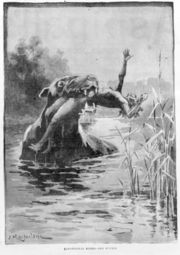This Day in Bunyip History
Posted by: Loren Coleman on October 14th, 2008
An 1890 drawing of a Bunyip.
Perth Gazette and Independent Journal of Politics and News
October 14, 1848
The Marine “Bunyip.”
Some months since, we extracted from the Port Philip journals, several accounts illustrative of a mysterious animal supposed to inhabit the lakes of that part of Australia, but a specimen of which had not been obtained, notwithstanding it had been seen by several individuals. Although at the time it was generally supposed that it was a mere “creature of the imagination,” parties were constantly on the watch to endeavor to solve so interesting a question as the existence or non existence of an undescribed animal, inhabiting the waters of Australia. It would appear from the following, taken from a late number of the Geelong Advertiser, that it is an animal belonging to the seal family.
“This creature, which was shot a few days ago at William’s Town, is now exhibiting in Geelong. We have of course seen it, and like all the rest who have done so, do not know what to call it, although there can be no doubt of its belonging to the seal family. Its length from muzzle to tail is 11 feet 2 inches, girth round the middle 5 feet, girth of head 3 feet 1 inch, length from muzzle to first joint of flipper 3 feet 2 inches, thence to extremity of fingers 2 feet 4 inches, thigh bone of hind nipper 2 feet long, thence to extremity of toes 1 foot 10 inches; the extremities are webbed, and possess all the characters of fins, each finger and toe being terminated by a nail or claw; the spread of each hind flipper is 2 feet 9 inches; the muzzle and nostrils resemble a calf’s; it has no ears. The most singular part of its organization is the disposition of its hind flippers, which protrude far beyond the caudal extremity, and look like a double tail. Its teeth consist of 4 incisors, 2 canine, and 10 molars in each jaw, the latter being tri-conical. The whole body is covered with a short sleek fur, except on the palms of the flippers, which are bare. The colour varies from dark grey on the back to silvery white on the belly, variegated with lighter spots and stripes on the sides. The arms and thighs are completely enveloped in the skin, but appear to be capable of very extensive motion in its natural element; indeed there is reason to suppose that in the water its hind flippers do not protrude back, but are drawn under the body as if in a sitting posture; there appears to be a great flexibility of spine which favours this opinion. The principal points of difference between this animal and the common seal, are the absence of ears, the shortness of the head, and the disposition of the hinder extremities. The common seal of the British seas however is very different from the common seal of the Australian waters, and so far as the absence of ears goes is similar to the animal now exhibiting.”
(Thanks to Jerome Clark for this archival item.)
About Loren Coleman
Loren Coleman is one of the world’s leading cryptozoologists, some say “the” leading living cryptozoologist. Certainly, he is acknowledged as the current living American researcher and writer who has most popularized cryptozoology in the late 20th and early 21st centuries.
Starting his fieldwork and investigations in 1960, after traveling and trekking extensively in pursuit of cryptozoological mysteries, Coleman began writing to share his experiences in 1969. An honorary member of Ivan T. Sanderson’s Society for the Investigation of the Unexplained in the 1970s, Coleman has been bestowed with similar honorary memberships of the North Idaho College Cryptozoology Club in 1983, and in subsequent years, that of the British Columbia Scientific Cryptozoology Club, CryptoSafari International, and other international organizations. He was also a Life Member and Benefactor of the International Society of Cryptozoology (now-defunct).
Loren Coleman’s daily blog, as a member of the Cryptomundo Team, served as an ongoing avenue of communication for the ever-growing body of cryptozoo news from 2005 through 2013. He returned as an infrequent contributor beginning Halloween week of 2015.
Coleman is the founder in 2003, and current director of the International Cryptozoology Museum in Portland, Maine.











Pity the drawing of the creature clearly shows ears whereas the text makes a point of the fact that there are no ears !!!
Perhas the Bunyip legend was based on a species of Australian seal with an unusual appearance that has now gone extinct. Shame if true.
The seal hypothesis is an interesting one. If true, even if it is now extinct in Australia, it may still exist in New Zealand as the cryptid Waitoreke, which is almost certainly a seal. I’ve always found the similarities between them intriguing.
I’ve often wonder if the Waitoreke and in particular the Bunyip were not inspired, at least in part, by encounters of leopard seals (Hydrurga leptonyx) outside of their native range. Aside from being a predator, and having been known to both attack and investigate humans, individuals sometimes wander up into Aus and NZ.
Tellingly, the leopard seal (like most Antarctic seals) does not have external ears, can reach up to about 11 feet or so, and even the dentition matches the description here. Google leopard seal skulls and check it out for yourself… Its a pity that this specimen has not been preserved, from the sound of it, but it is extremely intriguing.